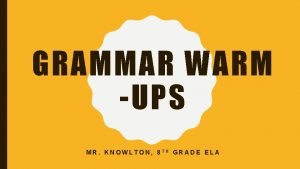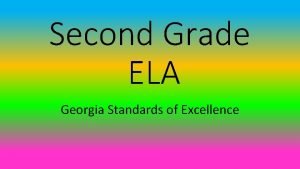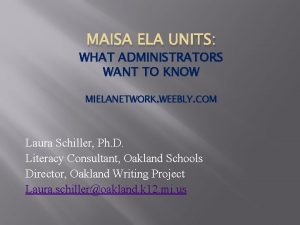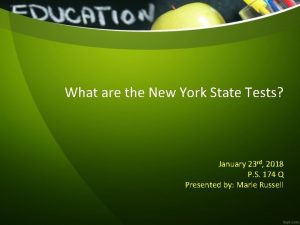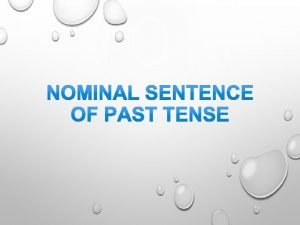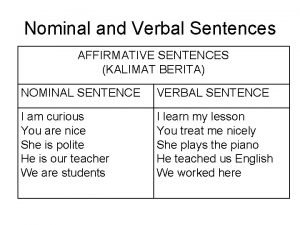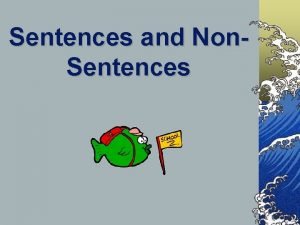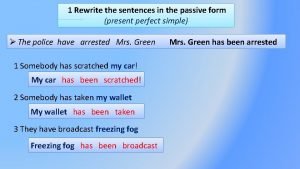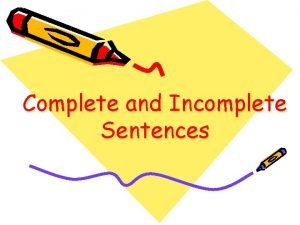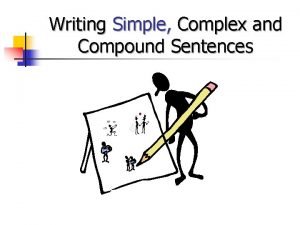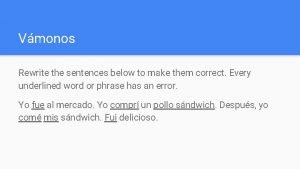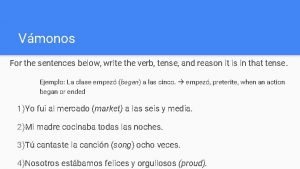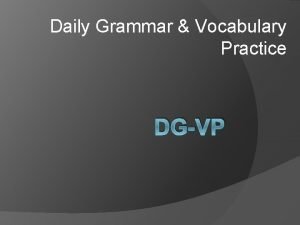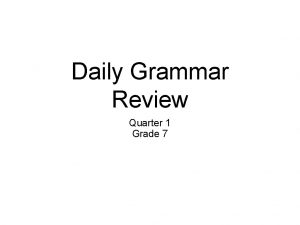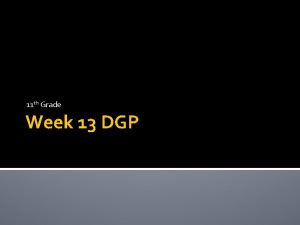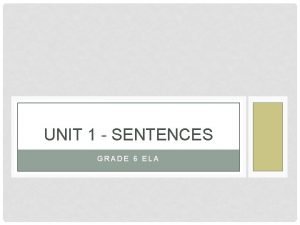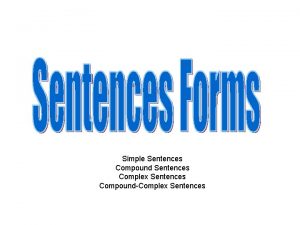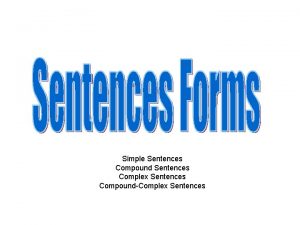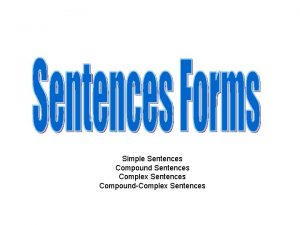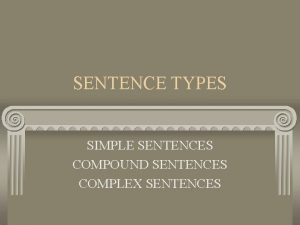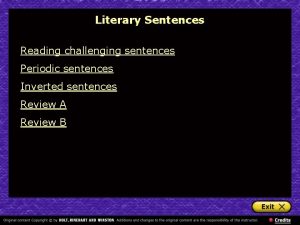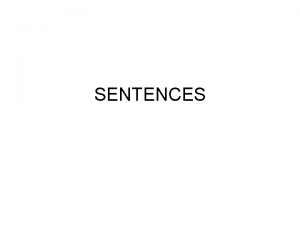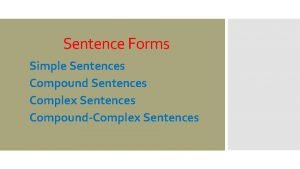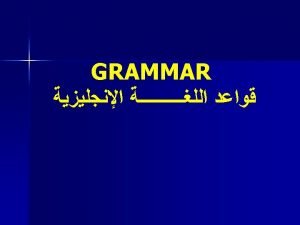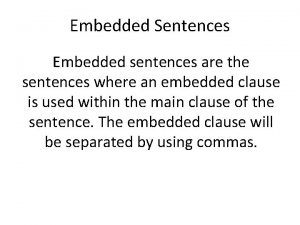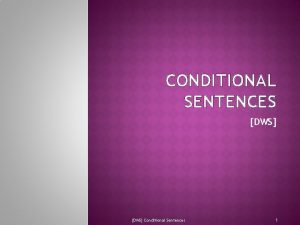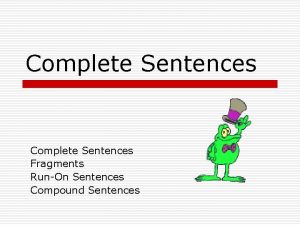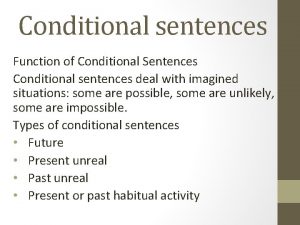UNIT 1 SENTENCES GRADE 6 ELA UNIT 1
















- Slides: 16

UNIT 1 - SENTENCES GRADE 6 ELA

UNIT 1 TOPICS - SENTENCES • • Sentence types Subject/predicate Simple subject/simple predicate Compound subject/compound predicate Avoiding fragments and run-ons Sentence structures • Simple • Compound • Complex

LESSON 1: IDENTIFYING SENTENCES • A sentence is a group of words that expresses a complete thought. • A sentence has a subject and a predicate. • A subject is who or what the sentence is about. • A predicate tells what the subject is or does. • Every sentence begins with a capital letter. Subject Predicate Mosquitoes can transmit disease. Mosquito-control agencies try to reduce the mosquito population.

PRACTICE: LESSON 1 • Read each sentence and draw a line in between the subject and the predicate. • 1. Mosquito eggs hatch quickly into larvae. • 2. Most mosquito species produce many generations each year. • 3. The male mosquito does not require blood meals. • 4. Malaria and yellow fever are spread by mosquitoes. • 5. Various kinds of insect repellents protect against mosquito bites.

PRACTICE: LESSON 1 DIRECTIONS: DRAW A LINE IN BETWEEN THE SUBJECT AND PREDICATE OF EACH SENTENCE. 1. Most ancient Egyptians worked as farmers, craftsmen, or scribes. 2. Farmers’ children worked in the fields with their parents. 3. The sons of craftsmen served as apprentices to their fathers. 4. Privileged boys received formal education as scribes. 5. A small group of people were priests and nobles. 6. The pharaoh dominated ancient Egyptian government. 7. The people of Egypt considered him a god. 8. The pharaoh’s advisory were the priests. 9. Both men and women in ancient Egypt wore cosmetics. 10. Oils and Creams protected people’s skin from the sun and wind.

LESSON 2: TYPES OF SENTENCES • There are four types of sentences. • Declarative sentences makes a statement and ends with a period. • Example: Volcanoes have magma chambers inside them. • Interrogative sentences ask a question and end with a question mark (? ). • Example: What is magma? • Imperative sentences gives a command or makes a request. • Example: Write your observations about the volcano in your journal. • Exclamatory sentences expresses strong emotion and end with an exclamation point (!). • Example: I can’t believe this volcano is 4, 000 years old!

PRACTICE: LESSON 2 • Directions: Determine the type of sentence. Add the correct end punctuation at the end of each sentence. 1. ________What happens when bubbles rise ___ 2. ________ In some volcanoes, lava oozes out slowly___ 3. ________Put your hiking boots on before going to the volcano___ 4. ________ How does density affect a volcano___ 5. ________Wow, that lava is hot___ 6. ________Mount St. Helens erupted in 1980 ___

PRACTICE: LESSON 2 DIRECTIONS: DECIDE WHETHER EACH SENTENCE IS DECLARATIVE, EXCLAMATORY, INTERROGATIVE, OR IMPERATIVE. THEN, ADD THE CORRECT PUNCTUATION. 1. _________ Irving Berlin was one of America’s most successful songwriters ____ 2. __________Do you know the names of any of his songs ____ 3. __________ Berlin couldn’t read or write music or play the piano very well _____ 4. __________ That’s incredible ____ 5. __________During World War II Berlin wrote a musical about the army ___ 6. __________Name the dates for World War II ____ 7. __________The show raised $10, 000 for charity ____ 8. __________ That’s what I call impressive _____ 9. __________ Berlin was born in Russia in 1888 ____ 10. __________Why did the family move to the United States ____

LESSON 3: SIMPLE SUBJECTS AND PREDICATES COMPLETE SUBJECTS AND COMPLETE PREDICATES • Simple subject is the one word that identifies who or what the sentence is about. • Example: • Engineers build. • Chinese engineers built the Great Wall. • Chinese engineers of the Ming Dynasty built many miles of the Great Wall. • Complete subject is the simple subject with all the words that describe it. • Example: • Chinese engineers built the Great Wall. • Chinese engineers of the Ming Dynasty built many miles of the Great Wall.

LESSON 3: SIMPLE SUBJECTS AND PREDICATES COMPLETE SUBJECTS AND COMPLETE PREDICATES • Simple Predicate is the one word that identifies what the subject did or was. • Example: • Engineers build. • Chinese engineers built the Great Wall. • Chinese engineers of the Ming Dynasty built many miles of the Great Wall. • Complete predicate is the simple subject with all the words that describe it. • Example: • Chinese engineers built the Great Wall. • Chinese engineers of the Ming Dynasty built many miles of the Great Wall.

LESSON 3: PRACTICE 1 Directions: Draw one line under the simple subject. Draw two lines under the simple predicate. 1. During the Tang dynasty, the Chinese made the first true porcelain. 2. A potter shapes pieces of porcelain on a potter’s wheel. 3. Porcelain workers decorate the pieces in a variety of ways. 4. Surface modification includes carving, perforating, or embossing a piece. 5. Many museums display Chinese painted porcelain.

LESSON 3: PRACTICE 2 Directions: Draw one line under the complete subject. Draw two lines under the complete predicate. Circle the simple subject and predicate. 1. During the Tang dynasty, the Chinese made the first true porcelain. 2. A potter shapes pieces of porcelain on a potter’s wheel. 3. Porcelain workers decorate the pieces in a variety of ways. 4. Surface modification includes carving, perforating, or embossing a piece. 5. Many museums display Chinese painted porcelain.

LESSON 4: AVOIDING FRAGMENTS & RUN-ON SENTENCES • Part 1: FRAGMENTS • A sentence must contain a subject and predicate to express a complete thought. If the sentence does not express a complete thought, it is called a sentence fragment. • Fragments: • Are slender and furry. (a subject is missing) • The furry otter. (a predicate is missing) • Complete Sentences: • Otters are slender and furry. (a subject was added) • The furry otter is related to the weasel. (a predicate was added)

LESSON 4: AVOIDING FRAGMENTS & RUN-ON SENTENCES • Part 2: RUN-ONs • A run-on sentence occur when you incorrectly join two or more complete thoughts without using any punctuation. • Run-Ons : • Bamboo is a giant form of grass its shoots are a tasty vegetable. • Corrected: • Bamboo is a giant form of grass. It’s shoots are a tasty vegetable. (Separate into two sentences) • Bamboo is a giant form of grass, and it’s shoots are a tasty vegetable. (Use a comma and conjunction)

LESSON 4: PRACTICE • Part 1 Directions: Identify the following group of words with an S for each complete sentence or an F for each fragment. 1. The otter’s oily fur, which forms a waterproof oat. ____ 2. River otters, once common in North America, are rarely seen. ____ 3. Are afraid of humans. ____ 4. Webbed toes and strong tails make otters excellent swimmers. ____ 5. Paddling with their feet and using their strong tails to steer. ____ 6. Prized for their rich fur like their relative the mink. ____ 7. In the 1800’s, otters were trapped heavily and began disappearing. ____

LESSON 4: PRACTICE • Part 2 Directions: Identify the following group of words with an S for each complete sentence or an R for each run-on. Then, correct each run-on into a complete sentence. 1. Bamboo is one of the most interesting plants it is valued for its beauty and usefulness. ____ 1. Bamboo may be one of the world’s most useful plants. ____ 1. Bamboo grows in huge groves it serves as a natural buffer against floods, erosion and the earthquake shocks. ____ 1. In addition, bamboo enriches the soil. ____ 1. People have found bamboo indispensable they use it for buildings, for musical instruments and for furniture. ____
 Grammar warm ups middle school
Grammar warm ups middle school Elagse
Elagse Maisa units
Maisa units Mcas ela grade 10
Mcas ela grade 10 Engageny ela grade 5 released questions
Engageny ela grade 5 released questions Write three positive sentences of nominal sentences
Write three positive sentences of nominal sentences Urutan kalimat yang benar
Urutan kalimat yang benar Sentences and non sentences
Sentences and non sentences Rewrite the sentence in passive
Rewrite the sentence in passive Complete incomplete sentences
Complete incomplete sentences Compound sentences
Compound sentences Write each of the two sentences below as one sentences
Write each of the two sentences below as one sentences Write the sentences below in the past simple.
Write the sentences below in the past simple. My friend jose will travel here on tuesday
My friend jose will travel here on tuesday Dgp sentences 7th grade answers
Dgp sentences 7th grade answers Dgp sentences 7th grade answers
Dgp sentences 7th grade answers Grade 6 sentences
Grade 6 sentences
